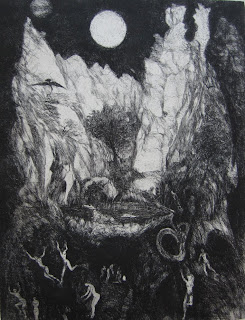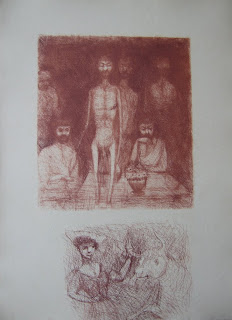�douard Goerg�s vision of suffering
I�ve mentioned the etcher, lithographer and painter �douard Joseph Goerg in several previous posts, but never really focussed on his work. Born in Sydney, Australia in 1893, to French parents (his father was a champagne merchant, with whose bourgeois ethos �douard remained deeply at odds), Goerg was a very powerful artist, whose distorted figures and phantasmagorical compositions express a deep-seated sense of dread and apprehension. Goerg�s anguished soul is reflected in the texts he chose to illustrate, which include Dante�s L�Enfer (1950, etchings), Villiers de l�Isle Adam�s Nouveau contes cruels (1946, colour lithographs), and the Apocalypse (1945, black and white lithographs).
Goerg�s majestic two-volume edition of Baudelaire�s poems, Les Fleurs du Mal (1948) and Tableaux Parisiens (1952) is often cited as his major work. It�s certainly a monumental achievement, containing 269 monochrome lithographs, all designed to surround and interact with the text. I have just one of the Baudelaire lithos, from one of the 30 suites in black of the lithographs without the text (there were also 10 suites in sanguine and 10 suites in black of the first state of the lithos). It�s one of the 33 double-page images, but without consulting the book I can�t say for sure which poem it relates to.
As a piece of bookmaking, the Baudelaire may well be Goerg�s masterpiece, but in terms of printmaking, the images don�t really work on their own without the text. My own favourite series of �douard Goerg prints is the set of etchings he made in 1946 for Le Livre de Job. There are 24 large etchings, printed hors-texte, and a further 7 small etchings integrated with the text. The Book of Job with its poetic vision of suffering was the perfect inspiration for Goerg, and he rises to its challenges with what for me is his best work. The etchings for Job inevitably invite comparison with Marc Chagall�s etchings and lithographs for the Bible. But whereas Chagall�s essential nature is sunny and outgoing, Goerg�s is dark, brooding, and introspective.
�douard Goerg, etching for Le Livre de Job, 1946
�douard Goerg, etching for Le Livre de Job, 1946
�douard Goerg, etching for Le Livre de Job, 1946
Pierre Mornand and J.-R. Thom� write of �douard Goerg in Vingt Artistes du Livre (1955) that �le tragique hante l��me d��douard Goerg��tragedy haunts his soul. Goerg was indelibly marked by the horrors of the First World War, in which he was mobilized and saw active service in Greece, Turkey, and Serbia. Later he witnessed the terrible rise of fascism in Europe. After the fall of France, Goerg�s first wife, who was Jewish, went into hiding, and died because she could not get access to medical care. �douard Goerg fell into a deep depression, for which he was treated with electroconvulsive therapy. It was out of this darkness that his haunting etchings for the Book of Job (and his equally intense and disturbing etchings for Dante�s Inferno) arose.
�douard Goerg, etching for Le Livre de Job, 1946
�douard Goerg, etching for Le Livre de Job, 1946
�douard Goerg, etching for Le Livre de Job, 1946
Mornand and Thom� write of etchings for Job, �Goerg uses all the alchemy of etching to evoke the profound meaning of the enigmatic Book of Job, whose obscure and troubling lamentations are a prophecy of future calamities.� They compare his mastery of light and shade in these etchings to both M�ryon and Rembrandt.
�douard Goerg, etching for Le Livre de Job, 1946
�douard Goerg, etching for Le Livre de Job, 1946
�douard Goerg, etching for Le Livre de Job, 1946
Comparisons of Goerg to others are never easy, just as it is hard to identify him with any particular school. He is most often classed as an Expressionist, but in French terms that is really just a term for the artists who don�t seem to fit anywhere else, such as Goerg or Henry de Waroquier. There is some influence from James Ensor, some from Odilon Redon, some from George Grosz. I think one can also see that Goerg looked closely at the work of both Chagall and Modigliani. There�s also a deep-rooted debt to Flemish masters such as Bosch and Breughel.
Goerg�s teachers at the Acad�mie Ranson from 1913-1914 were Paul S�rusier and Maurice Denis, and there is certainly a direct influence from Denis in his work; later Goerg was to be involved with Denis�s Atelier de l�Art Sacr�.
Goerg was also, of course, influenced by his direct contemporaries and friends, most notably Marcel Gromaire, Gus Bofa, the �Prince of Montmartre� Jules Pascin, and Pascin�s close friend Per Krohg.
It was Jean-�mile Laboureur who introduced �douard Goerg to etching in early 1920s. I have two important series of Goerg�s etchings from this period�a rare suite of his etchings for Knock ou le Triomphe de la M�dicine by Jules Romains (1926), and his 14 etchings for Fr�d�ric Boutet�s Tableau de l�Au-Del� (1927). Both exhibit a lively strain of black humour.
I only have the suite of 12 etchings for Knock, not the book. There were 39 suites of the etchings in their final state.
Tableau de l�Au-Del� (Portrait of the Beyond), with its witty depictions of various seekers after the supernatural, shows the early Goerg at his satirical best. It was published in an edition of 347 copies.
�douard Goerg, etching for Tableau de l'Au-Del�, 1927
�douard Goerg, etching for Tableau de l'Au-Del�, 1927
In the 1920s, �douard Goerg was a member of Jean Cocteau�s circle, and had well-documented problems with opium; I am indebted to a reader of this blog, Beno�t, for the information that Goerg kept his supply of opium stashed in his paintbox. Opium dreams may account for the hallucinatory quality of his work.
�douard Goerg, etching for Tableau de l'Au-Del�, 1927
�douard Goerg, etching for Tableau de l'Au-Del�, 1927
I also have a very rare suite of 28 etchings with remarques, printed in sanguine, of �douard Goerg�s 1947 edition of Edgar Allan Poe�s L�Ange du Bizarre (in Baudelaire�s translation, of course). There were 275 copies of the book, and 25 suites. According to Luc Monod, these suites were printed in black, so either he is mistaken, or there was also an even smaller number printed in sanguine.
�douard Goerg, etching with drypoint remarque for L'Ange du bizarre, 1947
�douard Goerg, etching with drypoint remarque for L'Ange du bizarre, 1947
�douard Goerg, etching with drypoint remarque for L'Ange du bizarre, 1947
The Poe etchings are very striking (Mornand and Thom� speak of their �extraordinary power�). Dreamlike and mysterious, they seem to hover at the very edge of intelligibility. The remarques, added to the plate with a drypoint needle, essentially provide 28 further images, sometimes closely related to the original image, sometimes seemingly disconnected from it.
�douard Goerg, etching with drypoint remarque for L'Ange du bizarre, 1947
�douard Goerg, etching with drypoint remarque for L'Ange du bizarre, 1947
�douard Goerg, etching with drypoint remarque for L'Ange du bizarre, 1947
In 1949, Goerg won the important Prix Hallmark for a painting of the Nativity. In the same year he was appointed professor of printmaking at the �cole des Beaux-Arts, Paris. In 1950 he won the Prix de Gravure de Lugano, but in fact his career as a printmaker was virtually at its end. He re-married, and his second wife encouraged him to return with renewed vigour to painting. His colourful paintings of sensual and decadent �filles-fleurs� from this period earned him renewed popularity. He became the president of the Soci�t� des Peintres-Graveurs Fran�ais, and in 1965 was elected to the Acad�mie des Beaux-Arts.
�douard Goerg, etching with drypoint remarque for L'Ange du bizarre, 1947
�douard Goerg, etching with drypoint remarque for L'Ange du bizarre, 1947
�douard Goerg, etching with drypoint remarque for L'Ange du bizarre, 1947
�douard Goerg died at Callian in the Var in 1969, at the age of 76. According to his Wikipedia entry, Goerg was planning to leave his wife, and his death was �mysterious�. This seems appropriate for an artist whose work is always suffused with a sense of mystery. He was truly, as Mornand and Thom� say, a �po�te fantastique et magicien de l�irr�el�poet of the fantastic and magician of the unreal.�
































